Signals from the sky. Satellite communication systems
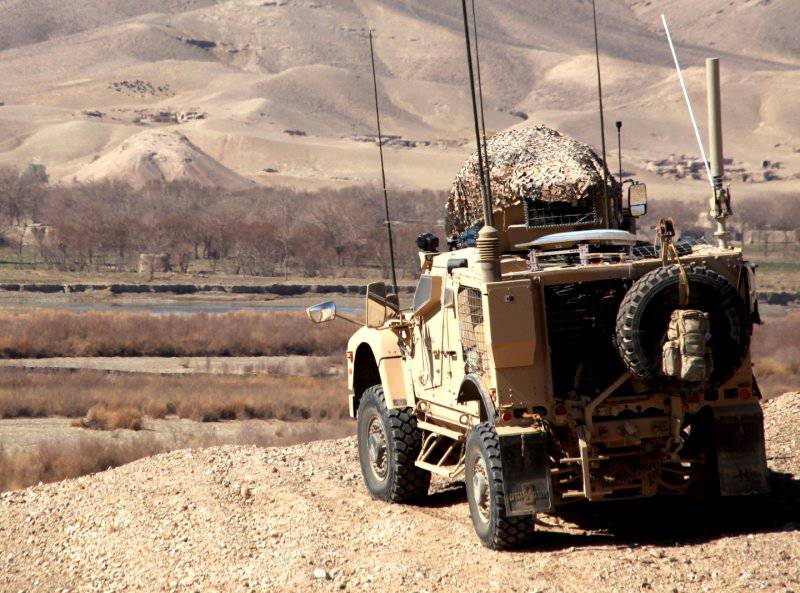
ITT Exelis's Gnomad system is available in portable and portable configurations. Satellite terminal Gnomad can transfer data at speeds up to two Mbps
Modern armies rely on communications at high frequencies (HF) (Eng. High Frequency (HF)), very high frequencies (VHF) (Eng. Very High Frequency (VHF)) and super high frequencies (UHF) (Eng. Ultra High Frequency (UHF)) for the purpose of transmitting voice and information traffic between divisions and echelons. Mobile satellite communications offer an exponential increase in the amount of traffic that can be processed on today's battlefield, and the range over which this traffic can be sent and received.
HF communications, typically using the 3 - 30 megahertz (MHz) band of the electromagnetic spectrum, provide over-the-horizon communications and are used everywhere in the armed forces of the whole world. Yet HF have their drawbacks. They use the ionosphere to reflect the transmitted radio signals back to Earth. This provides impressive ranges, but at the same time HF may be vulnerable to weather conditions and solar activity. VHF, occupying the 30 - 300 MHz band, can transmit high levels of information and voice traffic and have good immunity to atmospheric and electromagnetic interference, but unlike HF, they can provide communication only within the line of sight, i.e., they can be blocked by elevations. UHF occupy the range from 300 MHz to 3 GHz and, like VHF, they provide a range of direct line of sight, and small antennas are also needed to operate on them. The latter feature reduces the physical parameters of the transmitting / receiving stations, although communications in this range can seriously suffer from the weakening caused by the presence of water droplets in the atmosphere. They absorb radio waves and thus reduce signal strength. Satellite communications (SS) typically use X-band for receiving data from Earth in the 7,9 - 8,4 GHz wavelength range and 7,25 - 7,75 GHz wavelength band for transmission to Earth, along with the Ku-band (12 - 18 GHz) and Ka-band ( 26,5 - 40 GHz). It is worth noting that some military satellite communication terminals also use relatively low-frequency C-band (0,5 - 1 GHz).
The advantages provided by satellite communications include its long range due to the reflection of waves from the antenna of the spacecraft and the large amount of information that it can process. Increasingly, telecommunications equipment providers are providing satellite communications to the military at the tactical level, equipping them with terminals, which they can activate within a few minutes with vehicle-mounted systems providing satellite communications in motion. The field of military satellite communications for the ground forces includes everything from large, strategic level fixed and mobile antennas and terminals that can be used to connect the deployed headquarters with the national command, and then descending down to the small portable and mobile terminals mentioned above. The article examines portable and mobile satellite systems, and larger strategic terminals will be considered in future articles.
DRS Defense Solutions
Antenna with diameters of 1,2 and 1,8 meters MFAST (Multi-band Flyaway Auto-acquisition Satellite Terminal) from DRS Defense Solutions can be assembled by one person in 15 minutes. Once installed, a satellite connection is provided with the push of a button. The whole set is transported in three standard aviation shipping boxes. Larger satellite terminals are supplied by DRS as a trailer or vehicle mounted 2,4m antenna available in the C, X, Ku and / or Ka bands. Those users who need CC on the move can choose the Ku-38V Low Profle COTM (Continuous On-Te-Move) antenna from DRS Technologies. The high-capacity Ku-38V antenna is designed to deliver continuous voice, data and video traffic in a small and lightweight enclosure, while low power consumption helps reduce physical stress on the vehicles carrying the equipment. X-band users can choose a "related" unit, the X-38V Low Profle COTM antenna. A Ku-band COTM satellite antenna is added to the Ku-38V antenna. Like its sibling, it offers high-bandwidth voice, data and video, although it is available on demand and in an X-band configuration with DRS's X-Band Satellite XOTM.
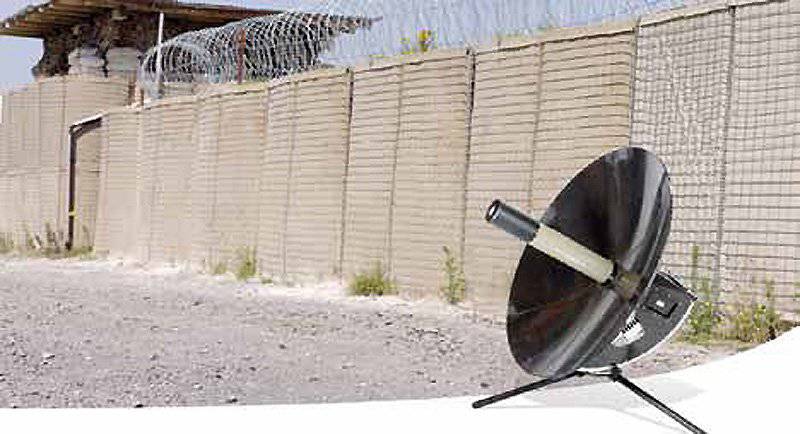
The South African company MicroVision Satellite Systems supplies military satellite systems for soldiers, for example this MicroVSAT portable antenna.
Telecomsys
Telecomsys offers two remarkable satellite terminals, Swiflink DVM-90 and Swiflink DVM-100. The first has a Ku-band 0,9 antenna as part of a broadband lightweight and compact satellite terminal. DVM-90 is shipped in two standard shipping cases and deployed in 20 minutes. During operation, the terminal has a bandwidth from 64 Kbps to 4,2 Mbps.
Israeli products
For many readers, it will be slightly surprising to learn that Israel is very successful in mobile military satellite communications as well as in traditional military communications. Commtact manufactures the Most (Mobile Satellite Terminal) which offers full-duplex communication in the Ku and Ka bands and includes an advanced stabilization and polarization mechanism that allows Most to track its satellite while the vehicle is moving. The Elbit catalog includes MSR-3000, MSR-PRO and MSR-R terminals. The MSR-3000 portable terminal of X, Ku and Ka ranges provides tactical SS, the whole kit weighs only 12 kg. Meanwhile, vehicles are equipped with a Ku-band Elbit MSR-2000 mobile terminal. MSR-2000 can be used with Elbit MSR-R and MSR-PRO hardened broadband routers and Elsat 2000 or Elsat 2100 low-profile antennas, with a diameter of 0,52 and 0,9, respectively.
Another Israeli specialist in military communications, IAI Elta, offers full-duplex, Ku-band satellite communications in the form of an EL / K-1891 mobile satellite terminal, which offers broadband data channels for land, sea and air applications. The Elta complements its EL / K-1891 terminal with several antennas up to one meter in diameter, a compact transceiver and a lightweight, high-performance stowow amplifier. The branded portable satellite communications complex includes the EL / K-1895 Manpack Tactical satellite terminal, which processes voice, data traffic and compressed video. The user can choose the location of the terminal next to him or remote control - either through a portable computer or through a handheld device. Another useful feature of EL / K-1895 is that it is pre-programmed to search for available communications in the Ku band and connects with them independently after the start of work.
L3 Communications
While EL / K-1895 offers communications in the Ku band, the AN / USC-66 KaSAT satellite communications system from L3 Communications operates in the Ka band, providing the US Army with long-distance communications using the Wideband Global Satcom satellite group (WGS). WGS is a bilateral program of the US and Australian defense ministries that will significantly increase the capacity of the satellite channel available to the military of each country. This grouping may also offer similar opportunities for Canada, which has signed up as a WGS program partner. The WGS satellite group complements the existing Defense Department satellite communications grouping of the United States Department of Defense Defense Satellite Communication System-III (DSCS-III) from 14 satellites, the last of which was launched in the 2003 year. WGS will replace DSCS-III satellites as they are decommissioned. As far as performance is concerned, WGS satellites offer instant, switchable bandwidth on 4,875 GHz, which is ten times greater than the capabilities of the existing DSCS-III system. The first WGS system under the designation “USA-195” has a bandwidth of 2,5 Gb / s. This already exceeds the throughput of all DSCS-III satellites combined. In total, the WGS network will include seven satellites, of which four are already operating.
L3 Communications has built up a rapidly deployable and dismountable AN / USC-66 system. It is transported in four 40-kg containers and can be installed on vehicles. Mobile platforms can use the Mobile Satellite Terminal Terminal On-The-Move IP Data System from L3 Communications, which provides broadband mobile satellite communications based on Internet Protocol (IP). Another company’s NCW-1200 terminal (Network Centric Waveform - network-centric waveforms) with a 1,2 meter diameter provides satellite communications in the Ku-band. It consists of an unmodulated frequency band distributor, provisioning equipment, and an antenna pedestal alignment device — each component fits into its own container. The NCW-1200 terminal requires only an external power source and a laptop computer.
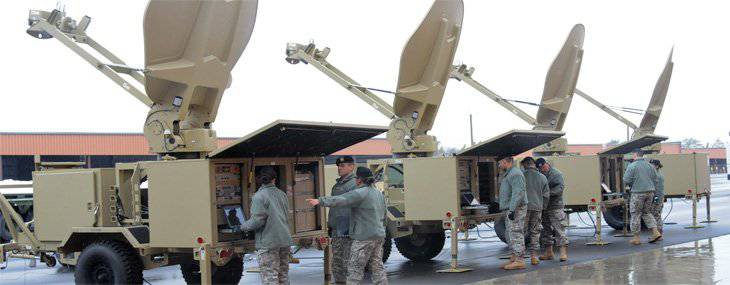
General Dynamics provides the military with a line of mobile satellite communications terminals in the form of its Warrior family. Pictured is the Warrior Model 240 system installed on the trailer.
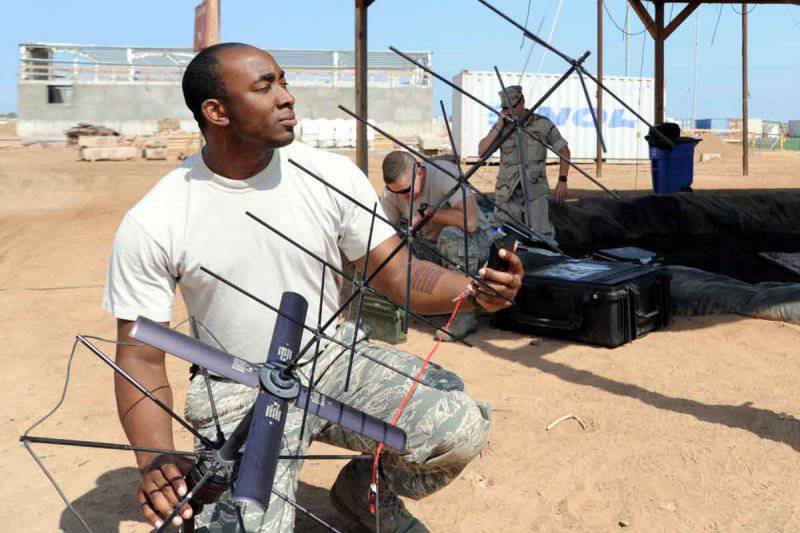
A US soldier tunes a Harris AN / PRC-117 programmable network radio station to establish satellite communications. The current trend is to provide each soldier with satellite communications capabilities at the expense of their personal radio stations.
TRM-1000 from L3 Communications combines an MPM-10000 IP modem with an antenna to transmit and receive traffic via WGS satellites (see above). The satellite broadband family of terminals covers all satellite communication frequency bands in a package that is compatible with the standard (JTRS) Sofware Communication Architecture 2.2 Core Framework and X-band WGS / XTAR satellite communication.
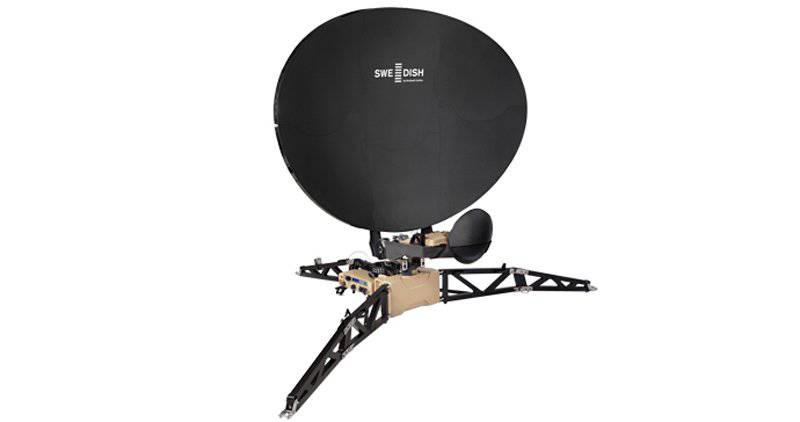
Satellite antenna Rockwell Collins CCT200 Swe-Dish based on the wishes of the customer is available in the X, Ku and Ka bands and has a data rate of 50 Mbps
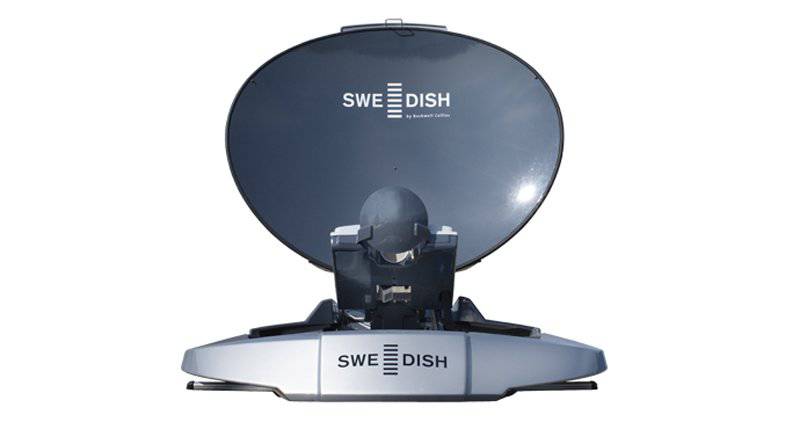
Rockwell Collins' CCT120 Swe-Dish Satellite Terminal CommuniCase Technology uses a modular approach to connect specific components, allowing users to get a customized system based on their specific needs.
Viasat Company
American troops also use the AN / PSC-14 terminal from Viasat's Broadband Global Area Network (BGAN) standard. It uses a broadband international satellite communications system (better known as Inmarsat), all hardware certified by the Type-1 encryption standard of the National Security Agency. With the AN / PSC-14 terminal, data rates of up to 422 Kbps are achievable; it can have either a backpack or a carry configuration.
ITT Exelis
Similarly, the US Army uses satellite terminals from ITT Exelis, including the Gnomad family (see the first photo), which has a common basic kit with an interchangeable antenna depending on whether the terminal is used in a wearable version or in a portable configuration. The company says that one of the key distinguishing features of the Gnomad family in comparison with other available satellite communication devices is its small size, mass, power and cooling parameters. The Gnomad family offers data rates of up to two Mbps and uses a commercial Ku-band satellite band, while the low-profile antenna used in the transported version has subtle features and does not interfere with rooftop equipment, such as remotely controlled combat modules. The terminals of the Gnomad family provide full-duplex voice, data and video transmission, and for security purposes they can be combined with Taclane KG-175 communication channel protection IP network Type-1 and National Security Agency's KIV-19 type-1 encryption device providing secure data transmission up to 50 Mbps. In addition, the user can connect Gnomad to the AN / VRC-92 single-channel radio station, tactical portable transceivers AN / VRC-104 and AN / VRC-110. The Gnomad system was sold to the second and fourth infantry divisions of the American army.
Harris Company
Harris is well known not only in the field of tactical radio stations, but also as a manufacturer of satellite communications equipment, such as the AN / USC-65 C / X / Ku / Ka terminal used by the United States Marine Corps. The AN / USC-65 terminal is being replaced by the modular advanced four-band MAQA antenna terminal (Modular Advanced Quad-Band Antenna) from Harris, which covers the same frequency band as the AN / USC-65 when using an 3,8-meter antenna. It will be able to communicate via the US satellite constellation WGS or the British Skynet-5, as well as through the standard frequency ranges of commercial satellites. Harris also offers a family of Seeker three-band satellite dishes with dish sizes 1,3 and 0,95 meters. With a data transfer rate of about five Mbps, the Seeker family has recently been certified for use with the WGS satellite communications system. These terminals were expected to be purchased by the command of special operations of the USA and several European countries-members of NATO.
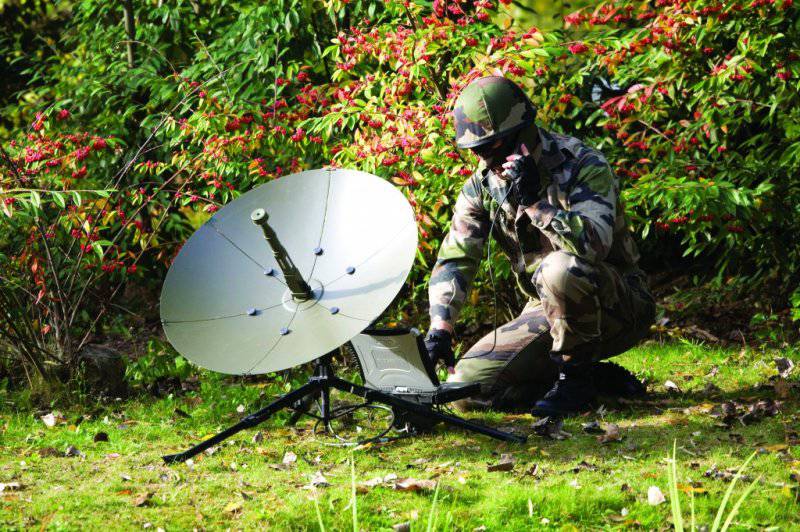
Thales is one of the leading providers of portable military satellite communications systems. The company’s portfolio includes a Talisman tactical satellite communications kit.
Rockwell Collins Company
Rockwell Collins also has a well-established lineage in the world of tactical radio stations and a large catalog of products for satellite communications. MiSAT portable terminals offer communication in the X and Ku bands with a weight of less than 18 kg, preparation for work takes less than five minutes, even for those who have no experience in the field of satellite communications at all. Similarly innovative solutions have the terminal CommuniCase Technology (CCT) Swe-Dish. It is based on a modular concept, that is, specific components can be combined to produce a solution that meets customer requirements. Modules include antenna, transceiver, processor, software, power supply, mounting and auxiliary products. When a new software module is added, this fixes and adapts the entire system accordingly. The intuitive GUI also reduces training time, and all modules can fit in one container. The MiSAT and CCT systems were acquired by special forces and harvested ministries around the world, as well as by the US Navy and National Guard.
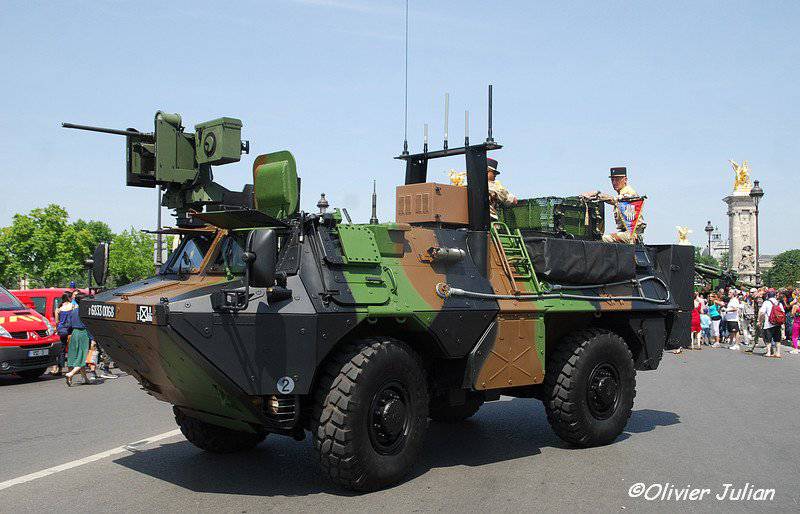
Thales was selected by the French defense agency to meet the immediate operational requirements for its KHM Venus mobile satellite communications, which provide X-band satellite communications in motion.
General Dynamics Company
Among the US manufacturers of mobile satellite communications systems, General Dynamics with its Warrior family is worth mentioning. The small portable terminal Warrior SMT (Small Man-portable Terminal) of this company provides high-speed data transfer in open and encrypted mode in X and Ka bands at 18 Mbps speed when receiving and 4 Mbps when transmitting data, preparing for work is 15 minutes The Warrior Model-96 connects to the Warrior SMT terminal, which handles the same frequency ranges and data rates (we can also say about the Warrior Model-120 terminal with the 1,2 antenna); It is carried in three shipping crates. Terminal with Warrior Model-1,8 180 antenna in addition to the C-band provides communication in X- and Ka-bands. General Dynamics also offers larger trailers on trailers, such as the Model-240 (2,8 antenna) and the AN / TSC-185 terminal, which provide satellite communications during a stop.
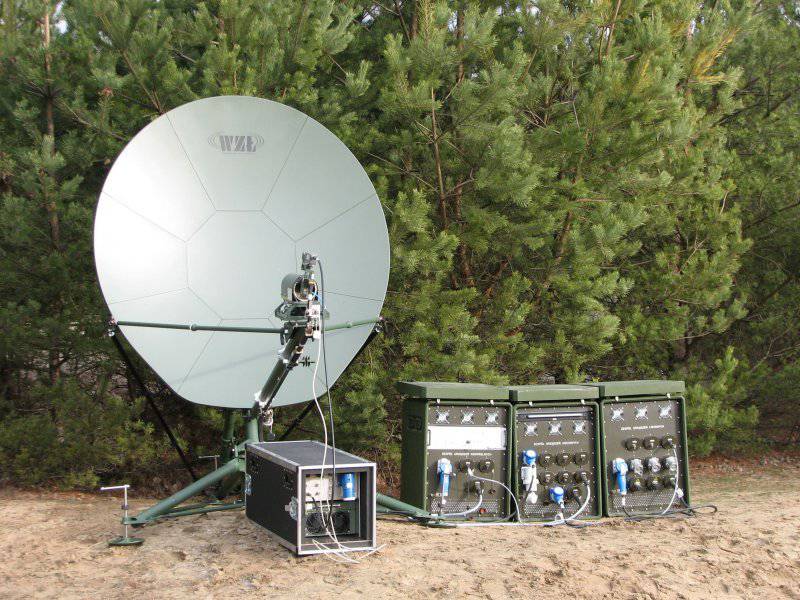
The systems from WZL have already been supplied to the Polish army for its contingent in Afghanistan, the largest system is the 1,8 terminal PPTS-1.8
Tales Company
European companies provide a significant proportion of satellite terminals for tactical ground-based applications. Tales offers focused on the System-21 data transmission system (also formerly known in the export version as Modem-21E). Modifications to Modem-21E over the entire life cycle included the addition of waveforms that increase its robustness to jamming, as well as work to increase the speed of data transmission that reached 32 Mb / s. System-21 provides the functionality of all software and hardware versions of the former Modem-21E model, as well as such new features as “Net-IP”, which controls the quality of network service in accordance with the requirements of the military. System-21 uses IP architecture and a special mode, which means that if the terminal loses communication with the satellite (for example, if an antenna is blocked by trees or tall buildings), the terminal “remembers” the connection and automatically reinstalls it when the satellite returns to view.
Tales also offers satellite solutions for vehicles united in the Satmove family. They are “machine independent” and are available either in a traditional parabolic design or in the form of a phased antenna array. The latter system, in particular, is useful for terrestrial vehicles moving on uneven and bumpy terrain, when a conventional antenna can lose communication with a satellite. Since the phased antenna array is electronically coordinated, it is much easier to maintain its direction to the satellite. In addition, Tales is responsible for the Talisman family of portable terminals, who are very fond of special forces around the world. Most Tales terminals are available in the X, Ku and Ka bands.
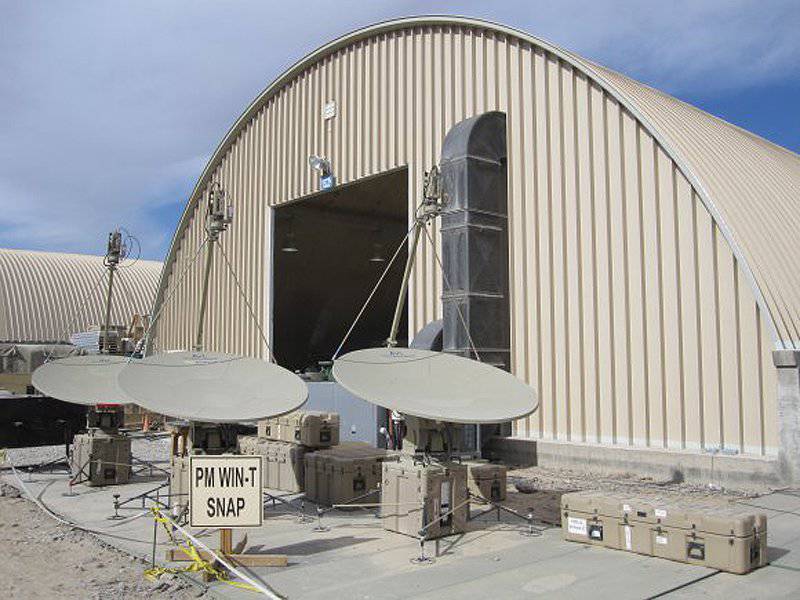
Although military satellite communications have traditionally used the X-band, this frequency range has become increasingly saturated with time. In connection with this, the military migrates to higher Ka-band frequencies.
Selex Elsag
The compact satellite terminal Talon Lite from Selex Elsag provides data transmission in the X-band or Ku-band, it consists of a one-meter antenna and two aluminum hardened transport containers weighing 20 - 30 kg. The Talon Lite architecture includes an ODU (Outdoor Unit) that is remotely connected to the Indoor Unit, which is used to monitor the system via a five-meter fiber-optic cable, although the user can extend it if desired to 1000 meters. An ODU consists of an antenna, a GPS receiver, a compass, and a tiltmeter to automatically capture the satellite based on the positioning information in the ODU memory. The IDU consists of a CDM570L-IP satellite modem and a monitoring and tracking computer.
With regard to technological trends in the field of mobile military satellite communications terminals in motion, there is a quiet revolution regarding the width of frequencies. Military satellite communications currently operate, as a rule, in the X-band spectrum. The X-band is resistant to jamming, but the relative narrowness of this segment available for military communications (500 MHz) means that it is very “oversaturated”. This was confirmed by the insatiable appetite of the United States and its allies for satellite frequencies during military operations in Afghanistan, Iraq and relatively recently in Libya.
Ku-band is relatively wider, but it is also very “full”, it is used extensively by the commercial sector. The Ka-band offers the necessary additional frequency range, providing one GHz for military communications and the same for commercial users. The technology picked up by the designers of the Ka-band military satellite terminals is currently able to offer equipment with small antennas at a competitive price that can use this part of the spectrum. Ka-band migration and recent military operations have shown that the high demand for satellite communications frequencies is so huge that this range will not last long.
Materials used:
Armada International
www.drs.com
www.commtact.co.il
www.thalesgroup.com
Information